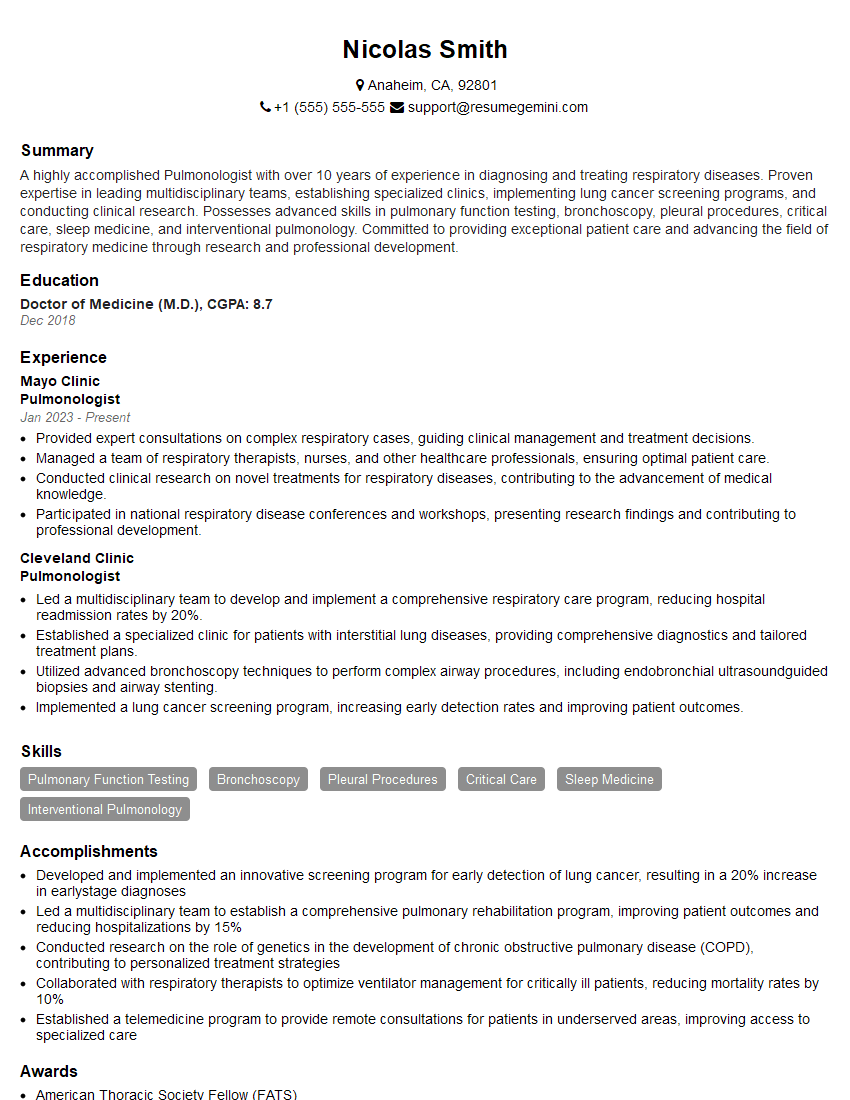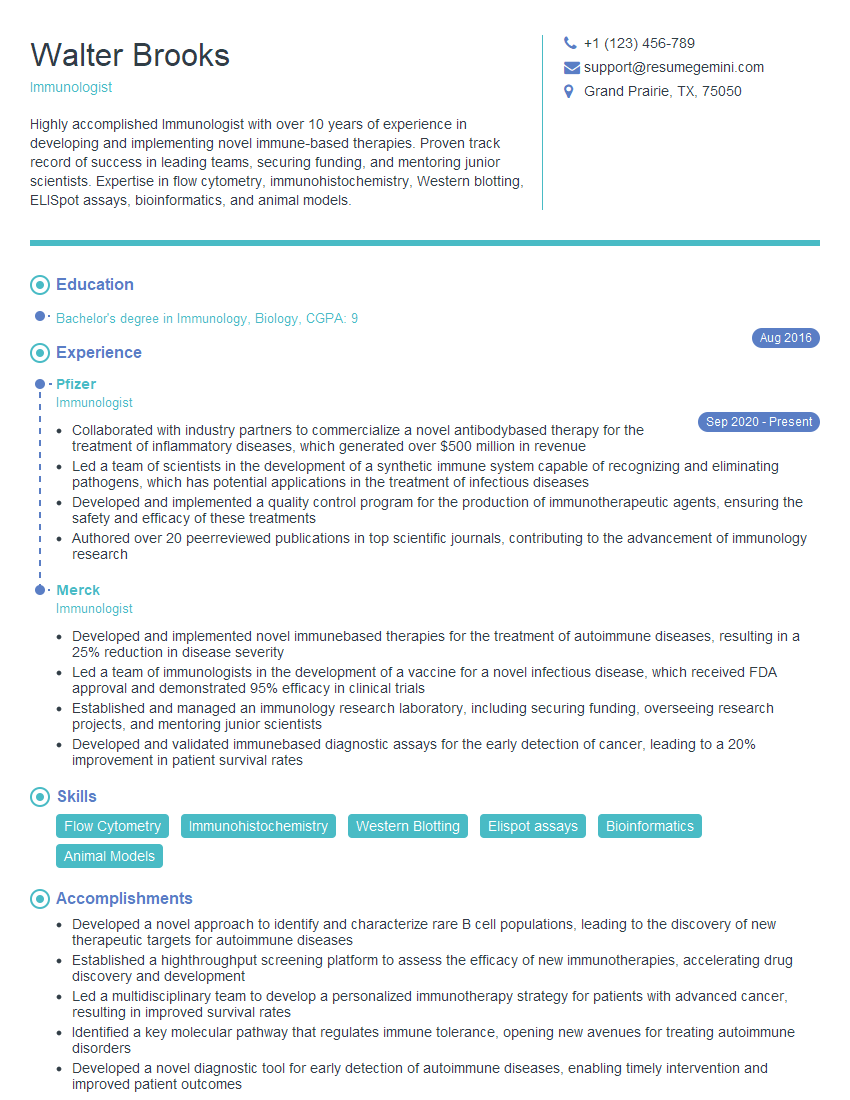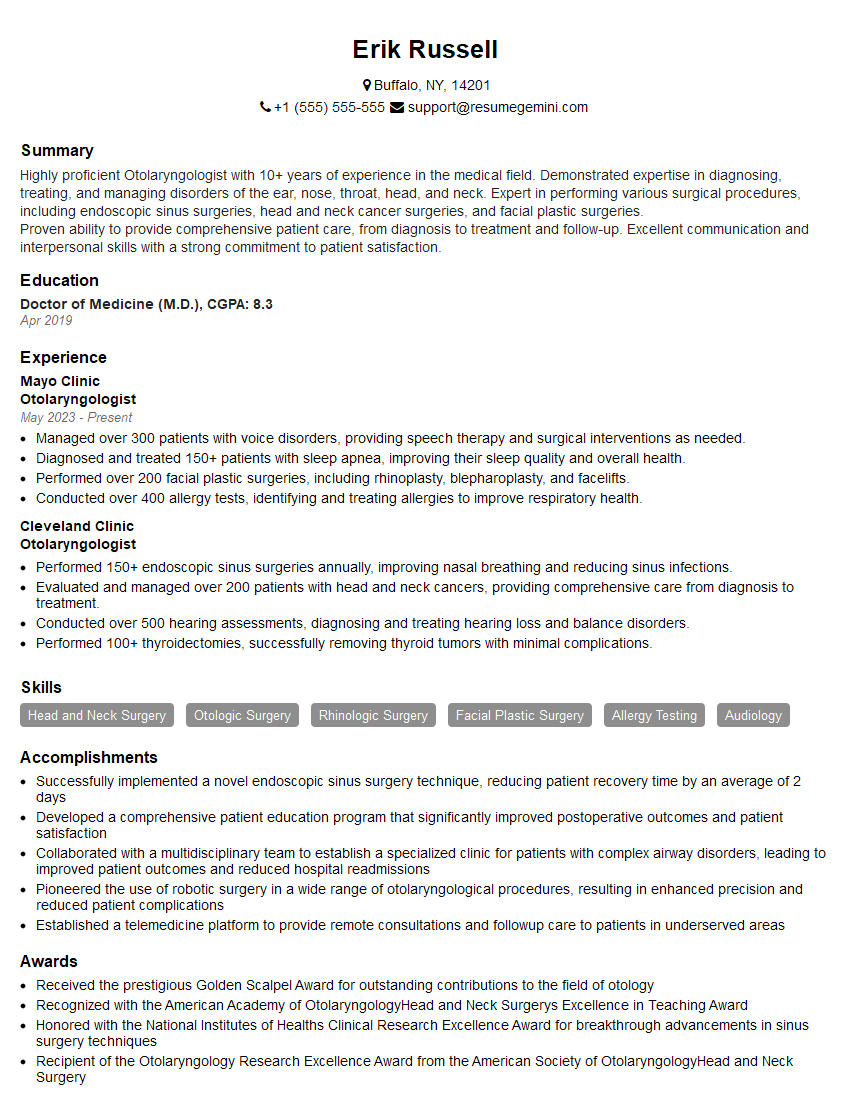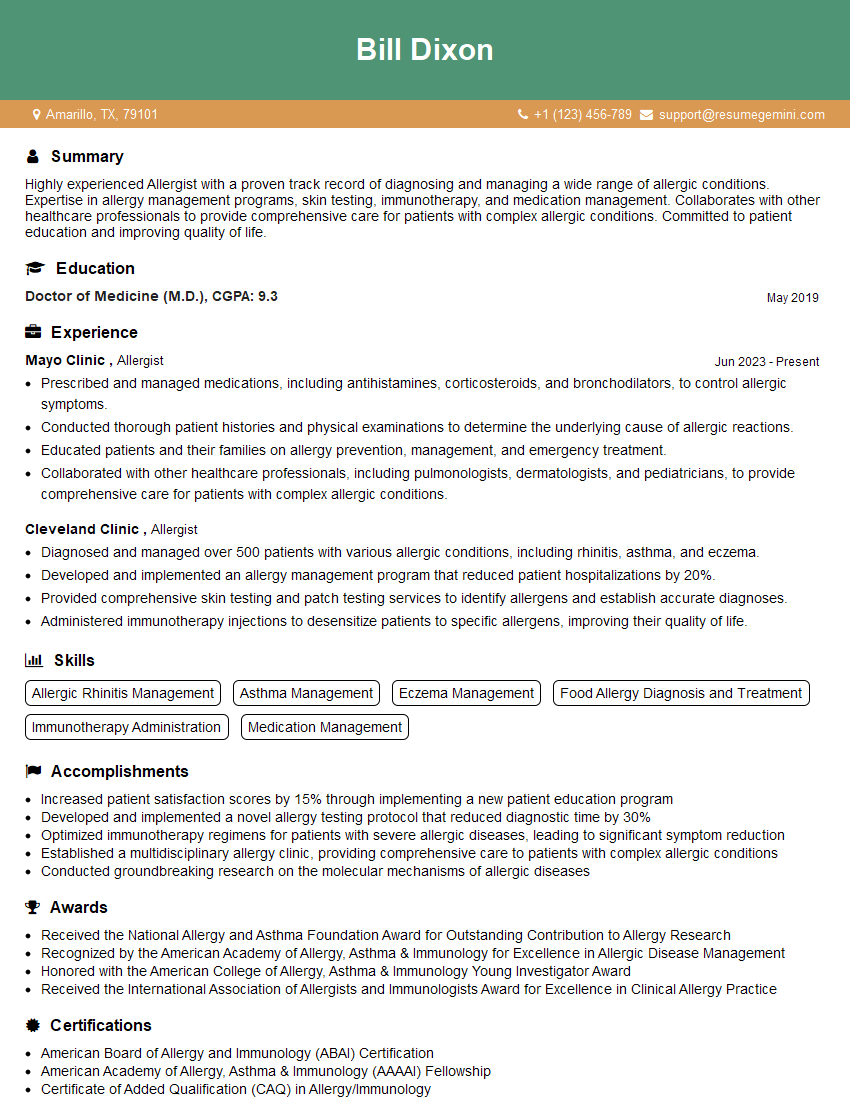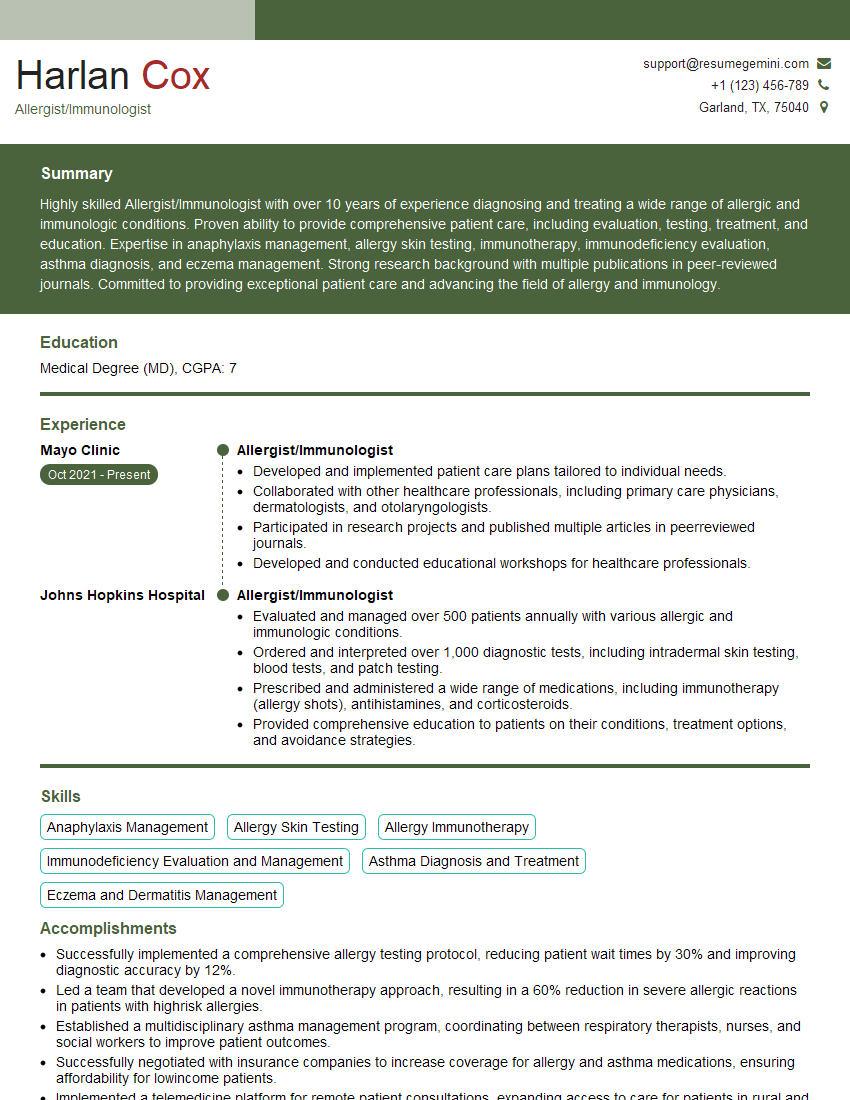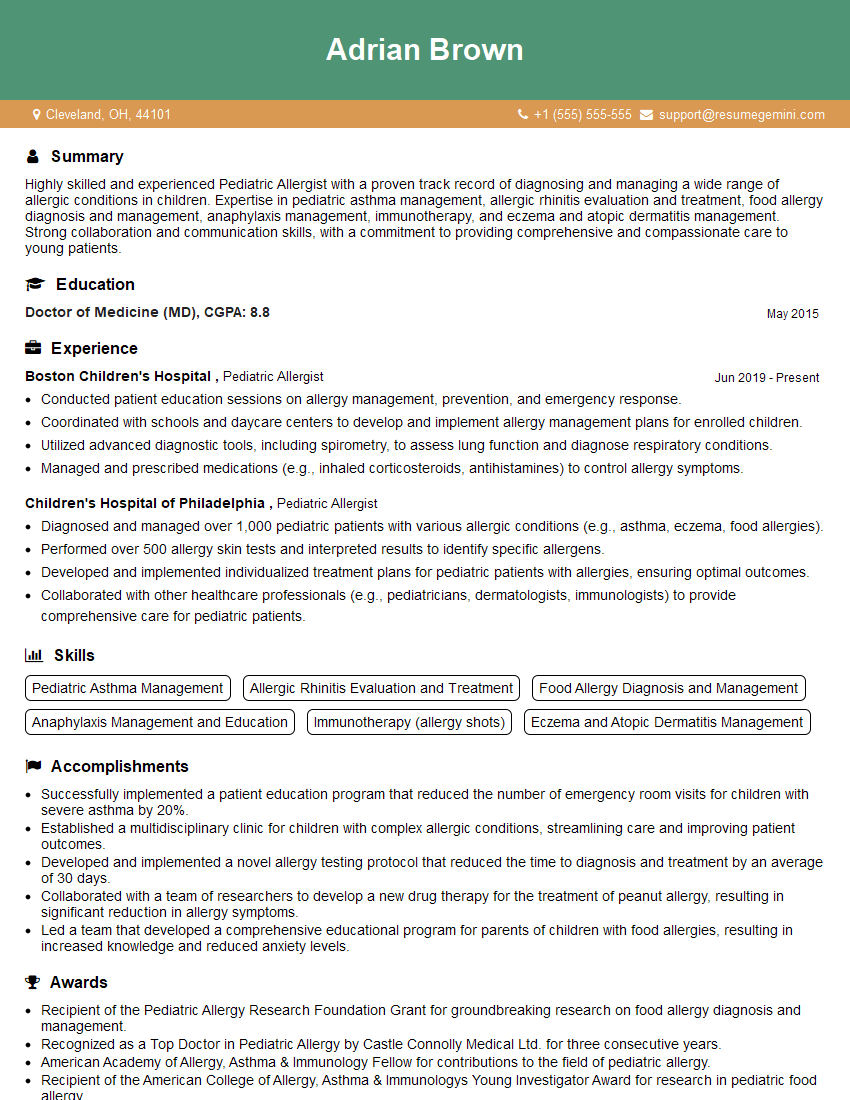The right preparation can turn an interview into an opportunity to showcase your expertise. This guide to Allergic Rhinitis interview questions is your ultimate resource, providing key insights and tips to help you ace your responses and stand out as a top candidate.
Questions Asked in Allergic Rhinitis Interview
Q 1. Explain the pathophysiology of Allergic Rhinitis.
Allergic rhinitis, or hay fever, is an inflammatory condition of the nasal passages triggered by an allergic reaction to airborne allergens like pollen, dust mites, pet dander, or mold spores. The pathophysiology is a complex interplay of immune system components.
It begins when an allergen is inhaled and encounters IgE antibodies previously produced by the body upon sensitization to that allergen. These IgE antibodies are bound to mast cells and basophils in the nasal mucosa. When the allergen binds to these IgE antibodies, it triggers a cascade of events: Mast cells and basophils degranulate, releasing histamine, leukotrienes, and other inflammatory mediators. These mediators cause vasodilation (widening of blood vessels), increased vascular permeability (leakiness), and smooth muscle contraction in the nasal passages.
This results in the classic symptoms of allergic rhinitis: nasal congestion, rhinorrhea (runny nose), sneezing, and itchy nose and eyes. Eosinophils and other inflammatory cells are recruited to the site of inflammation, perpetuating the allergic response. The severity of the reaction varies depending on the concentration of the allergen, individual sensitivity, and the amount of mediator released.
Q 2. Describe the difference between allergic rhinitis and non-allergic rhinitis.
While both allergic rhinitis and non-allergic rhinitis share similar symptoms like nasal congestion, rhinorrhea, and sneezing, they differ significantly in their underlying causes. Allergic rhinitis is an IgE-mediated immune response triggered by exposure to specific allergens, as detailed above. In contrast, non-allergic rhinitis lacks this specific allergic mechanism.
Non-allergic rhinitis encompasses various conditions that cause nasal inflammation without an IgE-mediated allergic reaction. These can include:
- Infections: Viral or bacterial infections of the nasal passages.
- Irritant-induced rhinitis: Caused by exposure to irritants like smoke, fumes, or strong odors.
- Hormonal changes: Fluctuations in hormones, such as during pregnancy or menopause, can affect nasal mucosa.
- Vasomotor rhinitis: Characterized by fluctuating nasal congestion due to changes in blood vessel diameter, often triggered by temperature or humidity changes.
- Medication-induced rhinitis: Side effects from certain medications.
The key differentiator lies in the absence of a demonstrable IgE-mediated allergic response in non-allergic rhinitis. Diagnosis often relies on a thorough history, physical examination, and exclusion of other causes.
Q 3. What are the common symptoms of Allergic Rhinitis?
The common symptoms of allergic rhinitis are often bothersome and can significantly impact quality of life. They can include:
- Nasal congestion: Stuffiness and blockage of the nasal passages.
- Rhinorrhea (runny nose): Watery discharge from the nose.
- Sneezing: Frequent bouts of sneezing.
- Itchy nose, eyes, palate, and throat: Intense itching sensations in these areas.
- Watery, itchy eyes: Conjunctivitis (eye inflammation).
- Postnasal drip: Mucus dripping down the back of the throat.
- Facial pressure: A feeling of fullness or pressure in the sinuses.
- Reduced sense of smell (hyposmia): Impaired ability to smell.
- Cough: Often caused by postnasal drip.
The severity of symptoms can vary widely depending on the individual, the allergen exposure, and other factors. Some individuals experience mild symptoms, while others experience significantly debilitating symptoms that disrupt daily activities.
Q 4. Discuss the various diagnostic tests used for Allergic Rhinitis.
Diagnosing allergic rhinitis typically involves a combination of methods focusing on identifying specific allergens and ruling out other conditions.
- Detailed medical history: This involves a comprehensive discussion of symptoms, their timing, and potential allergen exposures. Knowing the seasonality of symptoms, for instance, can point towards pollen allergies.
- Physical examination: The doctor examines the nose and throat for signs of inflammation, such as swollen nasal mucosa or pale conjunctiva.
- Skin prick test: This is a common method for identifying specific allergens. Small amounts of suspected allergens are applied to the skin, and the reaction (wheal and flare) is observed. This is a quick and reliable test.
- Serum-specific IgE test (blood test): This test measures the levels of IgE antibodies specific to certain allergens. It’s helpful when skin tests are not suitable or inconclusive.
These tests, combined with a careful history, allow for accurate diagnosis and treatment planning. It’s vital to differentiate allergic rhinitis from non-allergic causes.
Q 5. Outline the treatment options for Allergic Rhinitis, including pharmacotherapy and immunotherapy.
Treatment for allergic rhinitis aims to control symptoms and improve quality of life. The approach is usually multifaceted.
Pharmacotherapy: This involves using medications to alleviate symptoms. Common options include:
- Intranasal corticosteroids: These are the first-line treatment for many patients. They are highly effective in reducing nasal inflammation and symptoms. Examples include fluticasone, mometasone, and beclomethasone.
- Oral antihistamines: These block the effects of histamine, a major mediator of allergic symptoms. Both first-generation (e.g., diphenhydramine) and second-generation (e.g., cetirizine, loratadine) antihistamines are available, with second-generation agents generally preferred due to less sedation.
- Decongestants: These can provide temporary relief from nasal congestion but should not be used long-term due to the risk of rebound congestion. They are available as nasal sprays (e.g., oxymetazoline) or oral medications (e.g., pseudoephedrine).
- Leukotriene inhibitors: These medications block the effects of leukotrienes, another important mediator of inflammation (e.g., montelukast).
Immunotherapy (Allergy Shots): This involves gradually exposing the patient to increasing doses of the specific allergen(s) over time, building tolerance and reducing the immune response. It’s a long-term approach but can provide lasting relief for many individuals.
Q 6. Explain the role of allergen avoidance in managing Allergic Rhinitis.
Allergen avoidance plays a crucial role in managing allergic rhinitis, particularly when combined with medication. The effectiveness of avoidance depends on the specific allergen(s) involved and the degree to which exposure can be reduced. For example, someone with a pollen allergy might need to stay indoors during peak pollen seasons, while someone with a pet allergy might need to avoid contact with pets.
Specific avoidance strategies include:
- Minimizing exposure to indoor allergens: Regularly cleaning the house, using dust mite-proof covers for mattresses and pillows, and using air purifiers with HEPA filters can significantly reduce exposure to dust mites, pet dander, and mold.
- Reducing outdoor allergen exposure: Staying indoors during peak pollen seasons, wearing masks or sunglasses outdoors, and showering and changing clothes after being outdoors can help.
- Managing pet allergies: Keeping pets out of bedrooms, regular bathing of pets, and using air purifiers can reduce pet dander exposure.
While complete avoidance is often impossible, reducing allergen exposure can lessen symptom severity and improve the effectiveness of pharmacotherapy.
Q 7. Describe the different types of immunotherapy for Allergic Rhinitis.
Immunotherapy for allergic rhinitis primarily involves two forms:
- Subcutaneous immunotherapy (SCIT): This is the traditional “allergy shot” method. Patients receive injections of gradually increasing doses of allergen extracts under the skin, usually once or twice a week, over a period of several months to years. The goal is to desensitize the immune system to the allergen.
- Sublingual immunotherapy (SLIT): This newer method involves placing allergen tablets under the tongue daily. It offers convenience compared to injections and is generally well-tolerated. The mechanism is similar to SCIT in that it aims to modify the immune response to the allergen.
Both SCIT and SLIT are effective for many people with allergic rhinitis, offering long-term symptom control by altering the immune response. However, they are not suitable for all patients and require careful monitoring by an allergist.
Q 8. Discuss the side effects associated with common Allergic Rhinitis medications.
Allergic rhinitis medications, while highly effective, can have various side effects. These vary depending on the type of medication.
- Intranasal corticosteroids (e.g., fluticasone, mometasone): These are generally well-tolerated but can occasionally cause nasal dryness, irritation, nosebleeds, or throat irritation. In rare cases, they might lead to a slightly increased risk of infections.
- Oral antihistamines (e.g., cetirizine, loratadine): First-generation antihistamines (like diphenhydramine) are more likely to cause drowsiness, dry mouth, and blurred vision. Second-generation antihistamines are much less likely to cause drowsiness but may still cause dry mouth or headache.
- Decongestants (e.g., pseudoephedrine, phenylephrine): These can raise blood pressure, cause insomnia, nervousness, and rebound congestion (where congestion worsens when the medication is stopped). They should be used cautiously in individuals with hypertension or heart conditions.
- Leukotriene modifiers (e.g., montelukast): These medications are generally well-tolerated but can sometimes cause headache, nausea, or abdominal pain.
- Immunotherapy (allergy shots): While highly effective long-term, immunotherapy can cause injection site reactions (redness, swelling, itching), and in rare cases, more serious systemic reactions. Careful monitoring is essential.
It’s crucial for patients to discuss any potential side effects with their doctor. Often, side effects are mild and manageable, and the benefits of controlling allergic rhinitis symptoms outweigh the risks. Alternative medications can be tried if side effects are troublesome.
Q 9. How do you differentiate between Allergic Rhinitis and other respiratory conditions?
Differentiating allergic rhinitis from other respiratory conditions requires a careful evaluation of symptoms, history, and physical examination. Key features help distinguish it:
- Allergic Rhinitis: Typically characterized by itchy eyes, nose, and palate; clear, watery rhinorrhea (runny nose); sneezing; and nasal congestion. Symptoms are often seasonal or related to specific allergens (pollen, pet dander, dust mites).
- Non-allergic rhinitis: Shares similar symptoms but lacks the itch and is not tied to specific allergens. Causes can include viral infections, hormonal changes, or irritants.
- Sinusitis: Involves inflammation of the sinuses, often presenting with facial pain or pressure, thicker nasal discharge (often yellow or green), and decreased sense of smell. It may be bacterial, viral, or fungal.
- Common Cold: Usually involves a combination of rhinorrhea, cough, and fever. It is typically self-limiting and resolves within a week or two.
- Asthma: Characterized by wheezing, shortness of breath, and chest tightness. It often coexists with allergic rhinitis (the allergic march).
Allergy testing (skin prick test or blood test) can confirm an allergic component, further differentiating allergic rhinitis from other conditions. A thorough medical history, including symptom duration, triggers, and family history of allergies, is also critical.
Q 10. Explain the concept of the allergic march.
The ‘allergic march’ describes a progression of allergic diseases over time. It often begins in infancy or early childhood with atopic dermatitis (eczema), followed by allergic rhinitis, and later, asthma. This progression isn’t inevitable for everyone, but it’s a common pattern.
Imagine it like this: The immune system, for reasons not entirely understood, develops a heightened sensitivity to allergens. This sensitivity initially manifests as eczema, an inflammatory skin condition. As the child grows, this sensitivity extends to the respiratory system, resulting in allergic rhinitis. If left unmanaged, this can potentially lead to asthma, a more serious condition affecting the airways.
Understanding the allergic march is crucial for early intervention. Treating atopic dermatitis early might help prevent or delay the onset of allergic rhinitis and asthma. Early diagnosis and management of allergic rhinitis are also vital to prevent asthma progression.
Q 11. Discuss the management of severe Allergic Rhinitis.
Managing severe allergic rhinitis requires a multi-faceted approach, often involving a combination of therapies:
- High-dose intranasal corticosteroids: These are the cornerstone of treatment, often used at the highest tolerated dose.
- Oral antihistamines (second-generation): These can provide additional symptom relief, especially for itching and sneezing.
- Leukotriene modifiers: These can be added for further control, especially if symptoms are not well-controlled by corticosteroids and antihistamines.
- Immunotherapy (allergy shots or sublingual immunotherapy): This is a long-term treatment that aims to desensitize the immune system to the specific allergens causing the rhinitis. It’s a highly effective option for severe, persistent cases but requires commitment.
- Biologic therapies: For truly refractory cases, newer biologic therapies targeting specific inflammatory pathways may be considered. This is usually a last-resort option.
Close monitoring and regular follow-up with an allergist are essential to adjust treatment as needed and manage any potential side effects.
Q 12. What are the common complications of untreated Allergic Rhinitis?
Untreated allergic rhinitis can lead to several complications, impacting various aspects of a person’s life:
- Sinusitis: Chronic inflammation of the nasal passages can lead to sinusitis, causing facial pain and pressure.
- Otitis media (middle ear infection): Inflammation can spread to the middle ear, especially in children.
- Asthma exacerbation: Allergic rhinitis often coexists with asthma, and untreated rhinitis can trigger or worsen asthma attacks.
- Sleep disturbances: Nasal congestion can disrupt sleep quality, leading to daytime fatigue and reduced productivity.
- Reduced quality of life: Persistent symptoms can significantly impact daily activities, work performance, and overall well-being.
- Development of other allergies: Untreated allergies could lead to further development of additional allergies as part of the allergic march.
Addressing allergic rhinitis promptly and effectively helps prevent these complications, ensuring better health and quality of life.
Q 13. How do you assess the severity of Allergic Rhinitis in a patient?
Assessing the severity of allergic rhinitis involves considering several factors:
- Symptom severity: This is assessed using standardized questionnaires or scales that quantify the intensity of symptoms like nasal congestion, rhinorrhea, sneezing, and itching. A visual analogue scale (VAS) is also commonly used where patients rate their symptom severity on a scale.
- Impact on daily life: The doctor will inquire about how the symptoms affect daily activities, work, sleep, and overall well-being.
- Medication use: The frequency and type of medications currently used offer insights into symptom control and severity.
- Presence of comorbidities: The coexistence of conditions like asthma or sinusitis adds complexity and may indicate more severe disease.
Based on this comprehensive assessment, the allergist determines the severity as mild, moderate, or severe, guiding treatment decisions accordingly. For instance, mild rhinitis may only require simple avoidance strategies and over-the-counter medications, whereas severe cases necessitate a more aggressive approach with multiple medications or even immunotherapy.
Q 14. What is the role of environmental control in managing Allergic Rhinitis?
Environmental control plays a crucial role in managing allergic rhinitis by minimizing exposure to allergens. This involves several strategies:
- Regular cleaning: Frequent vacuuming, dusting, and washing of bedding in hot water can help remove dust mites and pet dander. Using high-efficiency particulate air (HEPA) filters in vacuum cleaners and air purifiers further reduces airborne allergens.
- Pet control: Keeping pets out of bedrooms and regularly grooming them can reduce allergen levels.
- Controlling humidity: Reducing humidity levels below 50% helps limit dust mite proliferation. Dehumidifiers can be useful in damp climates.
- Regular airing and ventilation: Opening windows for short periods (especially when pollen levels are low) can help improve air quality.
- Pollen management: Staying indoors during peak pollen times, using air conditioning, and showering after outdoor activities can reduce pollen exposure.
- Protective bedding: Encasing mattresses, pillows, and blankets in allergen-impermeable covers is particularly helpful for reducing dust mite exposure.
Implementing these strategies can substantially reduce allergen exposure and lessen the severity of symptoms, complementing medical treatments and improving overall quality of life for people with allergic rhinitis.
Q 15. Discuss the importance of patient education in the management of Allergic Rhinitis.
Patient education is paramount in managing allergic rhinitis. It empowers individuals to actively participate in their care, leading to better symptom control and improved quality of life. Think of it as providing the tools and knowledge for patients to become their own health advocates.
Effective education covers several key areas:
- Understanding the condition: Explaining what allergic rhinitis is, how it develops (allergen exposure triggering an immune response), and common triggers (pollen, dust mites, pet dander, etc.).
- Identifying personal triggers: Helping patients pinpoint their specific allergens through symptom diaries, allergy testing, and discussions about their environment. For example, a patient might realize their symptoms worsen during specific seasons or after visiting a friend with a pet.
- Medication usage: Clear instructions on how to use prescribed medications, including dosage, timing, and potential side effects. This includes emphasizing the importance of consistent use, even when symptoms improve.
- Environmental control: Strategies for minimizing exposure to allergens such as using air purifiers, regular cleaning, dust mite-proof covers, and avoiding known triggers whenever possible. A simple example is suggesting regular washing of bed linens.
- Symptom monitoring and follow-up: Teaching patients how to track their symptoms and when to contact their healthcare provider. This fosters a proactive approach to managing the condition.
By investing time in patient education, we build a strong therapeutic alliance and improve treatment outcomes.
Career Expert Tips:
- Ace those interviews! Prepare effectively by reviewing the Top 50 Most Common Interview Questions on ResumeGemini.
- Navigate your job search with confidence! Explore a wide range of Career Tips on ResumeGemini. Learn about common challenges and recommendations to overcome them.
- Craft the perfect resume! Master the Art of Resume Writing with ResumeGemini’s guide. Showcase your unique qualifications and achievements effectively.
- Don’t miss out on holiday savings! Build your dream resume with ResumeGemini’s ATS optimized templates.
Q 16. How do you counsel patients about medication adherence?
Counseling patients about medication adherence requires a multifaceted approach. It’s not just about giving instructions; it’s about understanding the barriers and creating a collaborative plan to overcome them.
- Identify barriers: I start by asking open-ended questions to understand the patient’s perspective. Are there financial constraints? Side effects? Forgetfulness? Complex medication regimens? Understanding the root cause is crucial.
- Simplify regimens: Whenever possible, I try to simplify medication schedules. Combining medications into a single daily dose can improve adherence. For example, a once-daily nasal steroid and an antihistamine is preferable to multiple doses throughout the day.
- Address side effects: Many patients discontinue medication due to side effects. Proactively discussing and managing these side effects (e.g., drowsiness from antihistamines) is critical. Sometimes, switching to a different medication can resolve the issue.
- Utilize technology: Pill organizers, smartphone reminders, and medication tracking apps can aid memory and improve adherence. These tools can be especially helpful for patients with busy schedules.
- Reinforce the importance of adherence: Emphasizing the long-term benefits of consistent medication use is vital. I often explain how uncontrolled allergies can lead to complications like sinusitis or asthma exacerbations.
Regular follow-up appointments provide opportunities to assess adherence, address concerns, and reinforce the treatment plan. The goal is to empower patients to actively manage their condition and improve their quality of life.
Q 17. Describe the different types of nasal corticosteroids and their mechanisms of action.
Nasal corticosteroids are the cornerstone of allergic rhinitis treatment. They work by reducing inflammation in the nasal passages, thereby alleviating symptoms like congestion, sneezing, and rhinorrhea. Different formulations are available, each with a slightly different mechanism and potency.
- Fluticasone propionate (Flonase, Veramyst): This is a widely used corticosteroid that inhibits the release of inflammatory mediators, reducing inflammation and improving nasal airflow.
- Mometasone furoate (Nasonex): Similar in action to fluticasone, mometasone also suppresses the inflammatory cascade, effectively managing allergic rhinitis symptoms.
- Beclomethasone dipropionate (Beconase AQ): Another effective nasal corticosteroid that reduces inflammation and improves nasal patency.
- Budesonide (Rhinocort): This corticosteroid works by binding to intracellular glucocorticoid receptors, suppressing the production of inflammatory mediators.
The mechanism of action is essentially the same across all nasal corticosteroids: binding to intracellular glucocorticoid receptors in nasal cells, reducing the production of inflammatory mediators like leukotrienes, prostaglandins, and cytokines. The differences mainly lie in their potency and duration of action. Choice of medication often depends on patient-specific factors like symptom severity and potential side effects.
Q 18. What are the indications for using antihistamines in Allergic Rhinitis?
Antihistamines are used to relieve symptoms associated with allergic rhinitis, primarily sneezing, itching, and rhinorrhea. They achieve this by blocking histamine receptors, preventing histamine’s effects on the body.
- Sneezing: Histamine is a major mediator of the sneeze reflex. Antihistamines effectively suppress this reflex, providing relief.
- Itching: Histamine contributes significantly to itching in allergic rhinitis. Antihistamines counter this effect.
- Rhinorrhea (runny nose): Although less effective than nasal corticosteroids in managing nasal congestion, antihistamines can help reduce nasal discharge.
- Conjunctivitis: Antihistamines are also helpful in managing the itchy, watery eyes frequently associated with allergic rhinitis.
First-generation antihistamines like diphenhydramine (Benadryl) are effective but often cause drowsiness. Second-generation antihistamines, such as cetirizine (Zyrtec), fexofenadine (Allegra), and loratadine (Claritin), tend to be less sedating, making them more suitable for daily use.
Q 19. Discuss the role of decongestants in Allergic Rhinitis treatment.
Decongestants provide temporary relief from nasal congestion by constricting blood vessels in the nasal mucosa. They are often used as a short-term adjunct to other therapies in allergic rhinitis, not as a primary treatment.
Types: Decongestants come in oral (pseudoephedrine, phenylephrine) and nasal spray (oxymetazoline, phenylephrine) forms. Oral decongestants have a systemic effect, while nasal sprays act locally.
Mechanism of action: They act by stimulating alpha-adrenergic receptors, causing vasoconstriction and reducing nasal swelling. This improves airflow and alleviates the feeling of stuffiness.
Important Note: Nasal decongestant sprays should be used for a limited time (no more than 3-5 days) due to the risk of rebound congestion. Prolonged use can lead to worsening congestion when the spray is discontinued. Oral decongestants can also have cardiovascular side effects, so their use should be guided by a physician, especially in individuals with pre-existing heart conditions.
Q 20. Explain the use of leukotriene modifiers in Allergic Rhinitis.
Leukotriene modifiers, such as montelukast (Singulair) and zafirlukast (Accolate), offer an alternative approach to treating allergic rhinitis. They work by blocking leukotrienes, inflammatory chemicals involved in allergic reactions.
Mechanism of action: Leukotrienes contribute to inflammation, bronchoconstriction, and mucus production in the airways and nasal passages. By blocking leukotriene receptors, these medications reduce inflammation and improve symptoms.
Indications: Leukotriene modifiers are often used as an add-on therapy for patients whose symptoms are not adequately controlled with other treatments, or for those who cannot tolerate other medications. They can be particularly helpful for patients with both allergic rhinitis and asthma, as leukotrienes are involved in both conditions.
Advantages: Leukotriene modifiers are generally well-tolerated, with fewer side effects than some other medications. They are also non-sedating and can be taken once daily.
Q 21. What are the contraindications and precautions associated with immunotherapy?
Immunotherapy, also known as allergy shots, is a long-term treatment that aims to desensitize the immune system to specific allergens. While effective, it has certain contraindications and precautions.
- Severe asthma or other severe respiratory conditions: Immunotherapy can potentially trigger severe allergic reactions in individuals with poorly controlled respiratory issues.
- Uncontrolled cardiac or other serious medical conditions: Patients with unstable medical conditions may not be suitable candidates.
- Recent or current significant infections: Infections can increase the risk of severe allergic reactions.
- Pregnancy or breastfeeding: Immunotherapy is generally avoided during pregnancy and breastfeeding.
- Use of beta-blockers: Beta-blockers can interfere with the management of potential adverse reactions.
Precautions include careful patient selection, gradual dose escalation, and close monitoring during and after each injection. Patients should be educated about the potential side effects and emergency procedures. A thorough medical history and allergy testing are essential before initiating immunotherapy.
Q 22. How do you monitor the efficacy of Allergic Rhinitis treatment?
Monitoring the efficacy of allergic rhinitis treatment involves a multi-faceted approach, focusing on both subjective and objective measures. Subjectively, we rely heavily on the patient’s self-reported symptom scores. This often involves using standardized questionnaires like the Rhinoconjunctivitis Quality of Life Questionnaire (RQLQ) which assesses the impact of symptoms on daily life. We track changes in scores over time to gauge treatment effectiveness. Objectively, we may use tools like nasal endoscopy to visually assess nasal inflammation, or measure nasal airflow to determine the degree of nasal obstruction. Blood tests may also be used to measure IgE levels, though this is less frequently used for monitoring ongoing treatment efficacy than for initial diagnosis.
For example, if a patient reports a significant reduction in their sneezing, nasal congestion, and runny nose after starting treatment, and their RQLQ score improves substantially, this indicates successful treatment. Conversely, if symptoms persist or worsen despite treatment, further investigation is needed to adjust the treatment plan.
Q 23. Discuss the challenges in managing Allergic Rhinitis in children.
Managing allergic rhinitis in children presents unique challenges. Children may have difficulty articulating their symptoms, making accurate assessment more complex. Compliance with medication regimens can be challenging, requiring careful parental involvement and education. Additionally, the safety profile of medications needs careful consideration, with some medications potentially having more side effects in children. Identifying and managing potential triggers, such as pet dander or dust mites, can also be difficult in the context of a child’s home environment. Lastly, comorbid conditions like asthma are more prevalent in children with allergic rhinitis, necessitating a holistic treatment approach that addresses both.
For instance, a young child might not be able to describe the difference between a stuffy nose and an itchy nose. Parents therefore play a critical role in monitoring their child’s symptoms and providing accurate information to the healthcare provider. Similarly, the choice of nasal sprays might be limited to avoid those known to cause growth retardation in children.
Q 24. Explain the role of genetic factors in the development of Allergic Rhinitis.
Genetic factors play a significant role in the development of allergic rhinitis. Individuals with a family history of allergies, particularly allergic rhinitis, asthma, or eczema (atopic dermatitis), are at a much higher risk of developing the condition. This heightened susceptibility isn’t solely determined by a single gene but rather involves a complex interplay of multiple genes. These genes influence the immune system’s response to allergens, leading to increased IgE production and subsequent inflammatory reactions. Specific genes associated with immune regulation have been identified as contributing to the development of allergic rhinitis, but the exact mechanisms are still under investigation.
Consider a child with both parents suffering from seasonal allergies. This child has a significantly increased likelihood of developing allergic rhinitis themselves, illustrating the hereditary component. The inheritance pattern isn’t always straightforward; even if only one parent has allergies, the child still faces a higher risk than the general population.
Q 25. Describe the impact of Allergic Rhinitis on quality of life.
Allergic rhinitis significantly impacts quality of life, extending beyond just nasal symptoms. The constant sneezing, itching, nasal congestion, and runny nose can disrupt sleep, leading to daytime fatigue and decreased concentration. This can negatively affect academic or professional performance. Furthermore, the symptoms can interfere with social activities and relationships. The chronic nature of the condition can cause significant stress and frustration. The RQLQ score, mentioned earlier, provides a standardized measure of this impact on daily functioning.
Imagine a student who suffers from severe seasonal allergies during exam periods. The constant need to blow their nose and clear their head can disrupt their concentration and negatively affect their performance. Similarly, a professional might find their work productivity diminished due to fatigue and lack of focus stemming from their allergies.
Q 26. How do you approach a patient with persistent Allergic Rhinitis despite treatment?
Persistent allergic rhinitis despite treatment necessitates a thorough reassessment. First, we need to confirm the accuracy of the diagnosis, ruling out other conditions that may mimic allergic rhinitis, such as nasal polyps or non-allergic rhinitis. Second, we meticulously review the patient’s treatment plan, ensuring proper medication usage and adherence. We explore potential reasons for treatment failure, including medication side effects leading to poor compliance, under-dosing, or the presence of co-morbidities. We investigate whether the identified allergens are accurately reflected in the current treatment.
For example, a patient on a low dose of intranasal corticosteroids might be experiencing inadequate symptom control. Increasing the dosage or switching to a different medication class might be necessary. If the patient’s allergy testing only covers seasonal allergens but they have undiagnosed perennial allergies, treatment targeting the latter might be crucial. A thorough review of environmental triggers and lifestyle modifications will also be part of the process.
Q 27. What are the latest advancements in the treatment of Allergic Rhinitis?
Recent advancements in allergic rhinitis treatment include the development of novel biologics targeting specific aspects of the allergic immune response. These therapies are particularly beneficial for patients with severe, uncontrolled allergic rhinitis. Sublingual immunotherapy (SLIT), which involves administering allergen extracts under the tongue, offers a convenient alternative to traditional subcutaneous immunotherapy (SCIT) and has shown promising results in building long-term tolerance to allergens. Improved formulation and delivery systems for existing medications, like more efficient nasal sprays, also contribute to enhanced treatment efficacy. The ongoing research into personalized medicine seeks to tailor treatments based on individual genetic profiles and allergic responses, aiming for more targeted and effective interventions.
Biologics, for example, offer a way to specifically target the inflammatory pathways involved in allergic reactions, unlike older medications that treat symptoms more broadly. SLIT provides a less invasive approach to immunotherapy, improving patient compliance compared to injections.
Q 28. Discuss the role of lifestyle modifications in managing Allergic Rhinitis.
Lifestyle modifications play a crucial role in managing allergic rhinitis. This involves identifying and minimizing exposure to known allergens. For example, patients allergic to dust mites should use dust-mite-proof covers for mattresses and pillows, regularly wash bedding in hot water, and maintain a clean, clutter-free environment. For those allergic to pollen, staying indoors during peak pollen times, particularly early morning and late afternoon, can significantly reduce symptom severity. Regular nasal irrigation using saline solutions can help remove allergens and irritants from the nasal passages. Maintaining a healthy lifestyle, including adequate sleep and stress management, can further bolster the immune system and improve overall well-being.
A person with pollen allergies could significantly reduce their symptoms by keeping their windows closed during high pollen counts, using an air purifier, and showering before bed to remove pollen from their hair and skin. For those with pet allergies, regular vacuuming and frequent bathing of their pets can be helpful, though pet removal might be the most effective step.
Key Topics to Learn for Allergic Rhinitis Interview
- Immunology of Allergic Rhinitis: Understand the underlying mechanisms, including IgE-mediated responses, mast cell activation, and inflammatory pathways. Consider the role of different immune cells and cytokines.
- Diagnosis and Assessment: Familiarize yourself with various diagnostic methods, from patient history and physical examination to allergy testing (skin prick tests, blood tests). Practice interpreting test results and formulating differential diagnoses.
- Management Strategies: Master the various treatment approaches, including pharmacotherapy (antihistamines, corticosteroids, decongestants, leukotriene inhibitors), immunotherapy (allergen immunotherapy), and lifestyle modifications.
- Pharmacokinetics and Pharmacodynamics of Allergic Rhinitis Medications: Understand how different medications work at a mechanistic level, their absorption, distribution, metabolism, and excretion. Be prepared to discuss potential drug interactions and adverse effects.
- Specific Allergens and their Impact: Gain a comprehensive understanding of common allergens (pollen, dust mites, pet dander, molds) and their impact on the development and severity of allergic rhinitis. Be prepared to discuss cross-reactivity between allergens.
- Patient Education and Counseling: Develop your ability to explain complex medical information to patients in a clear and concise manner. Practice communicating effectively about treatment options, side effects, and self-management strategies.
- Complications and Co-morbidities: Understand the potential complications of allergic rhinitis, such as sinusitis, otitis media, and asthma. Be prepared to discuss the interplay between allergic rhinitis and other respiratory conditions.
- Research and Current Trends: Stay updated on the latest research in allergic rhinitis, including novel therapeutic approaches and advancements in diagnostic techniques. Demonstrate your commitment to continuous learning.
Next Steps
Mastering Allergic Rhinitis is crucial for career advancement in related fields, opening doors to diverse roles and opportunities. To stand out, craft a compelling and ATS-friendly resume that highlights your skills and experience effectively. ResumeGemini is a trusted resource to help you build a professional resume tailored to the specific requirements of Allergic Rhinitis-related positions. Examples of resumes optimized for this field are available, providing valuable templates and guidance to shape your application materials for success.
Explore more articles
Users Rating of Our Blogs
Share Your Experience
We value your feedback! Please rate our content and share your thoughts (optional).
What Readers Say About Our Blog
This was kind of a unique content I found around the specialized skills. Very helpful questions and good detailed answers.
Very Helpful blog, thank you Interviewgemini team.
